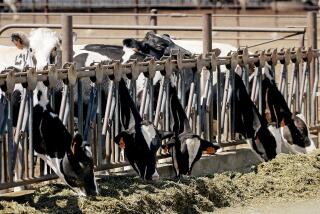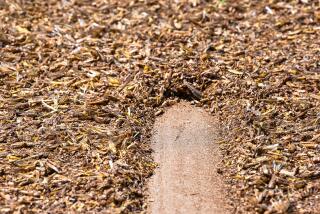El Nino’s Price Now and Later
- Share via
When you’re talking about the damage done to agriculture by this winter’s El Nino-influenced rainstorms, time is of the essence.
Do you mean short-term problems, like the damage the water did to fruit now being harvested? Do you mean medium-term problems, such as how the rain delayed plantings for crops that will be harvested this spring? Or is it long-term: How is this going to play out in the fall and beyond?
In the short term, there are three crops that have been badly damaged by rainy winter. Strawberries have borne the brunt of the storms, but in their case, most of the harm is extremely short-lived. Some fruit was lost, but few plants were damaged. Given a few more days of clear weather, things should be back to normal. (Indeed, wholesale prices fell by one-third from Monday to Friday of last week.)
More seriously damaged are artichokes and asparagus, both of which are centered in the hard-hit northern part of the state. According to Mary Comfort of the California Artichoke Advisory Board, the area around Castroville, just north of Monterey, has had 36 inches of rain this year, most of it in January and February. As a result, the spring artichoke harvest--normally the biggest of the year--will be 60% of normal. Sizes will also be affected as rain-soaked plants don’t have the energy to produce huge showcase ‘chokes.
Similarly, the asparagus harvest will be 20% to 25% below normal. And that’s only if this period of clear weather extends long enough that farmers can work their fields enough to revive flagging plants.
Prices for cauliflower and broccoli are also higher than normal, mainly because of the difficulty of harvesting rain-soaked fields.
In the middle term, look for prices of everything from iceberg lettuce to bottled salsa to be slightly higher this year. With fields so wet, farmers have been unable to prepare and plant. This will lead to sporadic short-term lettuce supply gaps this spring and a shortage of processing tomatoes that go into catsup and salsa.
In the long term, the rains have played havoc with almond growers as the heaviest rains fell during what should have been the peak period of pollination for the major varieties. It will be a month before anyone knows for sure, but it’s a pretty safe bet that this year’s harvest will be significantly smaller than last year’s.
If this current bit of clear weather doesn’t hold up, the same will be true for cherries, apricots, peaches, nectarines and plums. Pollination for those trees runs into late March and is just as susceptible to rain.
Even further ahead is long-term damage done to artichoke and asparagus plants. Because these are perennials and not replanted every year, this wet winter may be felt for two or three more years.
In the case of artichokes, about 500 acres of artichokes are going to have be be replanted because of the rain and won’t come into full production until they reach maturity in at least two years.
Asparagus is susceptible to crown rot, a root disease that diminishes each plant. Ironically, before the rain, this was supposed to be a very big year for the asparagus industry. “We were extremely enthusiastic that, with our increased production, we were going to have to embark on a program of accelerated domestic and international promotion,” says Bill de Paoli of the California Asparagus Commission. “Unfortunately, we’ve had to reevaluate our position.”
More to Read
Eat your way across L.A.
Get our weekly Tasting Notes newsletter for reviews, news and more.
You may occasionally receive promotional content from the Los Angeles Times.











